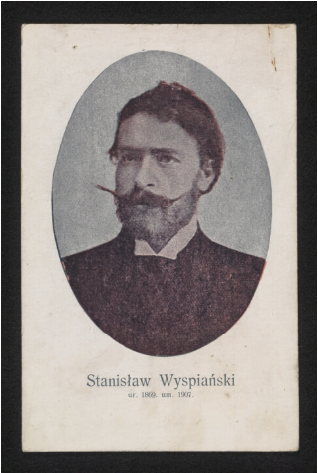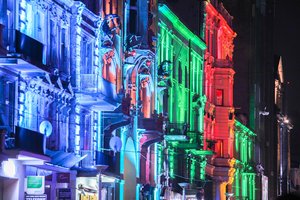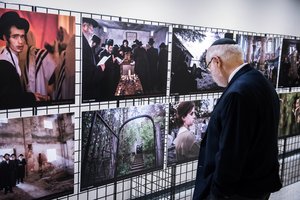Wyspiański is back in town
Stanisław Wyspiański – one of the most versatile Polish artists – associated his professional and private life with Krakow. Under Austro-Hungarian rule at the time, the city inspired him with its rich past and symbolism, but also with the challenges it faced. This led him to create his own vision of the capital of Galicia which he in part managed to portray. In his honour, the National Museum in Krakow is presenting the largest ever exhibition of his works, encapsulating this extraordinary relationship between his genius and the city he called his own.
 A Krakow resident
A Krakow resident
Stanisław Wyspiański was born on January 15, 1869 in Krakow. His mother Maria died when Stanisław was 7 years old, and his father Franciszek was a sculptor whose studio was located at the foot of the Wawel hill. The changes that took place in it in the nineteenth century symbolised the degradation of the entire city: the former seat of kings was turned into a barracks of Austrian troops, and Krakow was turned into a subordinate provincial city within the Habsburg empire. Nevertheless, for Poles it was a monument to lost better days, which sometimes manifested itself in the moderate cultivation of tradition, but it also allowed for the self-revision of ideas about oneself. History – received in different ways – was a regular visitor to the Galician city.
Young Stanisław studied at Saint Anna secondary school, where he became friends with future great figures of Krakow: Józef Mehoffer, Lucjan Rydel, Stanisław Estreicher. By being taught in two languages, he became assimilated in Polish and German literature and culture. The school also introduced him and his peers to the world of antiquity – which in Wyspiański's work would become a fixed point of reference. Having obtained a secondary school-leaving certificate, Wyspiański began painting studies at the School of Fine Arts under the guidance of the then famous Jan Matejko and at the same time he studied at the Faculty of Philosophy of the Jagiellonian University. While still a student, he participated in the renovation of St. Mary's Church, and in the summer he helped create an inventory of Galician monuments. Amongst his discovering was a wooden figure of Our Lady of Częstochowa from the fifteenth century in Podkarpacie.*
Artist of the Young Poland
 His artistic works were clearly influenced by his fascination with theatre that was being developed at school. Krakow's stages hosted the most talented Polish actors – including Helena Modrzejewska – and Wyspiański himself took on roles in amateur performances. Theatrical plasticity and sensitivity to detail, dynamism and movement, the story behind every detail combined with the emerging modernism and its encouragement to break the boundaries between the arts – all this influenced the young artist who was also increasingly willing to experiment: by painting on or creating stained glass, at the same time he also tried his hand in writing. He was encouraged by his journey through Europe: from Vienna, through Venice, Padua, Verona, Milan and other Italian cities to Paris – where he was impressed by the cathedral of Saint-Denis and from where he returned along the route of gothic cathedrals and great theatres. Despite his failure to join the École des Beaux Arts in Paris, he spent three more years in the City of Lights. His studies at one of the studios were an opportunity to get to know new aesthetic trends, and Gothic, whose great symbol, the cathedral, became the embodiment of total work, something which he himself began to strive towards.
His artistic works were clearly influenced by his fascination with theatre that was being developed at school. Krakow's stages hosted the most talented Polish actors – including Helena Modrzejewska – and Wyspiański himself took on roles in amateur performances. Theatrical plasticity and sensitivity to detail, dynamism and movement, the story behind every detail combined with the emerging modernism and its encouragement to break the boundaries between the arts – all this influenced the young artist who was also increasingly willing to experiment: by painting on or creating stained glass, at the same time he also tried his hand in writing. He was encouraged by his journey through Europe: from Vienna, through Venice, Padua, Verona, Milan and other Italian cities to Paris – where he was impressed by the cathedral of Saint-Denis and from where he returned along the route of gothic cathedrals and great theatres. Despite his failure to join the École des Beaux Arts in Paris, he spent three more years in the City of Lights. His studies at one of the studios were an opportunity to get to know new aesthetic trends, and Gothic, whose great symbol, the cathedral, became the embodiment of total work, something which he himself began to strive towards.
 Renaissance man
Renaissance man
After returning to Krakow, he associated his artistic path with the city. And he was so versatile as an artist! He prepared plans for the renovation of monuments, created stained-glass windows for the Franciscan church, prepared a graphic design of the modernist magazine "Życie", painted, drew, wrote dramas, illustrated books, designed furniture and theatre decorations, even created the outfit of the Krakow Lajkonik, which until today traverses the traditional route every June. Krakow was his scenery of choice, and sometimes the actual protagonist of his art pieces. In addition, he was involved in social and artistic life: he co-founded the Society of Polish Artists "Sztuka" and ran for the position of director of the Grand Theatre. Despite the lack of success in the latter, it must be said that he created a different theatre: a monumental one, sometimes called a total theatre – a type of spectacle that in the 1920s became one of the poetical forces driving theatre reform. What's more – in 1905 Wyspiański became a Krakow councillor, and after leaving the Wawel by the Monarchy army together with architect Władysław Ekielski, he prepared plan for development of the hill for almost a year. His funeral in 1907 became a national event. The artist was buried in the Krypta Zasłużonych na Skałce.
Visit Wyspiański in Kraków and get to know Wyspiański’s Krakow!
Up until April 2019, the largest temporary exhibition dedicated to the great Wyspiański will be held at the National Museum in Krakow. It it you can admire nearly 500 of the 900 works from the artist's collection. Apart from Wyspiański's donations to the National Museum, there are pastel masterpieces: stained-glass windows for cathedral windows, pencil drawings, charcoal, ink, pastels of pastel portraits and landscapes. The exhibition also features sculptures, illustrations, handicrafts and an art book. Accompanying the exhibition are publications and side-events, including lectures and walks following routes associated with the artist. On the Museum's website you can download maps – available in three languages – and an application. You can also book individual walks with a guide.
* The so-called Madonna from Krużlowa is currently in the collection of the National Museum in Krakow.
Poland.pl
13.09.2018







